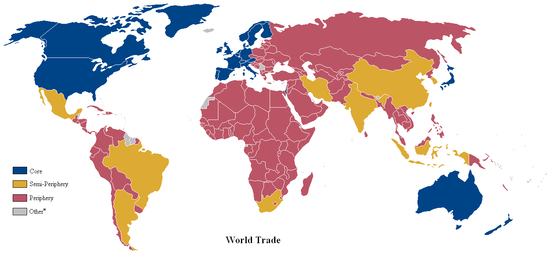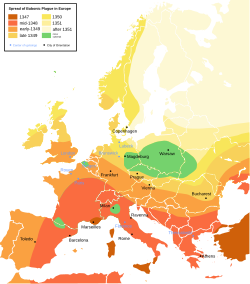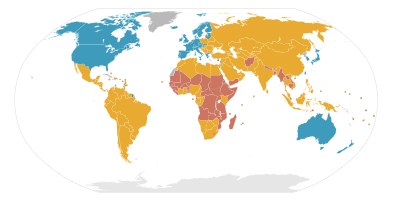
In world-systems theory, the semi-periphery countries (sometimes referred to as just the semi-periphery) are the industrializing, mostly capitalist countries which are positioned between the periphery and core countries. Semi-periphery countries have organizational characteristics of both core countries and periphery countries and are often geographically located between core and peripheral regions as well as between two or more competing core regions. Semi-periphery regions play a major role in mediating economic, political, and social activities that link core and peripheral areas.
These regions allow for the possibility of innovative technology, reforms in social and organizational structure, and dominance over peripheral nations. These changes can lead to a semi-periphery country being promoted to a core nation. Semi-periphery is, however, more than a description, as it also serves as a position within the world hierarchy in which social and economic change can be interpreted.
World-systems theory describes the semi-periphery as a key structural element in the world economy. The semi-periphery plays a vital role comparative to that of the role that Spain and Portugal played in the seventeenth and eighteenth centuries as intermediate trading groups within the European colonial empire.
Today, the semi-periphery is generally industrialized. Semi-peripheral countries contribute to the manufacturing and exportation of a variety of goods. They are marked by above average land mass, as exemplified by Argentina, China, India, Brazil, Mexico, Indonesia, and Iran. More land mass typically means an increased market size and share. Semi-peripheral nations are not all large though, as smaller countries such as Israel, Poland, and Greece can be described to exist within the semi-periphery.
Sociological theory
Semi-peripheral countries offer their citizens relatively diverse economic opportunities but also have extreme gaps between the rich and poor. World-system theorists originally used only two categories: periphery countries and core countries. A need for an in between category became quickly apparent, leading to the establishment of the semi-periphery category for societies that have moved away from the periphery but have not become core. In other words, the category describes societies that remain dependent, and to some extent underdeveloped, despite having achieved significant levels of industrialization. Semi-peripheral countries are tied into dynamic world systems that focus on the reliance of poor nations upon the wealthy, a concept known as the dependency theory. The term semi-periphery has been applied to countries that existed as early as in the thirteenth century. In theory, the creation of a semi-periphery category has added sociological and historical layers to previous developmental theories—yet it still has similar, inherently capitalist foundations.
Function
The semi periphery is needed to stabilize the world system, as it facilitates interaction and provides a connection between the low-income peripheral states and the high-income core states by adding another step in the world system hierarchy. As the middle ground, semi-peripheral countries display characteristics of both the core and the periphery. They also serve as a political buffer zone in that while they are exploited, they are also the exploiters. These areas have either been core regions in the past or formerly-peripheral areas that have since advanced in the world economy.
Semi-peripheral nations are a necessary structural element in a world-trade system, since such nations can serve to alleviate the political pressures that the core can exert upon the periphery and the political unrest that the periphery can direct back at the core. On the other hand, the semi-periphery can find itself excluded from the region's politics, as it lies just outside the bounds of political arena of the core states.
The semi-periphery exists because it needs to divide the economic power between the core and the periphery. Semi-periphery, referred to as the middle class by Wallerstein, is what makes the capitalist world function because it is much like the sociological structural functionalism theory, where norms, customs, traditions, and institutions act as "organs" that work toward the proper functioning of the "body" as a whole. Without these industrializing countries, change will never reach the periphery.
In terms of their contribution to industry and economy, the contemporary semi-peripheral states are semi-industrialized. Semi-peripheral countries are major exporters of minerals and agricultural goods. They are often focused in the manufacturing and exportation of industrial goods and commodities. While these advances separate the semi-periphery from the periphery, they lack the power and the economic dominance of core nations and still have a lot of un-managed poverty, placing them beneath the core. Semi-peripheral countries are important contributors to the world economy because of the above reasons and because they tend to have above average land mass, meaning that they are host to an above average market. A primary example is China, a country with not only a large area but with a large population.
History and development
13th century

This era of human history found the semi-periphery concentrated in the area stretching from the Middle East to China, including India and the Mongol Empire. This was the first time in history that the peripheries and semi-peripheries of the world became connected and involved in the trade of the world, both with cores and with each other. Through a lucrative trade system, including heavy taxing of goods traveling through their borders, they were able to maintain a steady stream of wealth, becoming the driving forces of economic change throughout this time period. In addition, a heavy emphasis on defense and border security, particularly among the Mongols, allowed them to be fairly impenetrable trade obstacles. Geography also played a role, as seen in India's development of an impressive maritime industry. Because of its position along a convenient route through the Indian Ocean, India established its role as a "hinge" between the East and West. Through their positions within the world trade system, semi-peripheries in the Middle East became crucially important in connecting the cities of Chinese and Indian cores with the fledgling cities of Europe, as well as serving as key points between other, more major core cities in the region, such as Baghdad, Cairo, and Aden.
1300–1450

Following increases in population and commerce in Western Europe in the thirteenth century, the feudal system met severe economic difficulties in the fourteenth and early fifteenth centuries. This decline in development was caused by a combination of the decline in agricultural production, the shrinking economy that had already hit its peak within the current feudal structure, and the devastating effects of the Black Plague epidemic. The regression of Western Europe into the semi-periphery and periphery allowed for the rise of the trading powers of Italy, most notably Genoa and Venice. These Italian city-states took advantage of their established trade connections with the Mongol Empire, the Far East, the Middle East, and the other Mediterranean powers to maintain their growth despite the economic failures of their European trade partners. Genoa and Venice had influence beyond their trade channels. Both were instrumental in the Crusades through their provisions of troops, transport vessels, and naval ships. Genoa also assisted the Byzantine Empire when it helped recapture the capital, Constantinople, in the late thirteenth century. The Byzantine Empire took advantage of its strategic position along various trade routes and the decline of Western Europe to rise to core status until its fall in 1453.
During this time period, Genoa and Venice developed forms of laissez-faire government and institutions that are viewed as precursors to modern capitalism. Despite these advances in influence and entrepreneurship, Genoa and Venice suffered from the crippling effects of the Black Plague, as much of the rest of Europe had before them. Venice was able to survive due to its connection with the Southern trade route, though her strength was much reduced by the middle of the fifteenth century. Genoa never fully recovered from the Black Death and its defeat at the hands of Venice in the late fourteenth century. The decline of Genoa and the shift in Venice's focus to the Red Sea trade route left the western Mediterranean and the Atlantic open to Portugal and Spain, who were already better positioned geographically to control Atlantic trade routes.
1450–1700

In a push to ensure stable economic growth, Europe turned to a capitalistic economy in the fifteenth and early sixteenth centuries to replace the failed feudal system. Modern capitalism allowed for economies to extend beyond geographical and political boundaries, leading to the formation of the first worldwide economic system. At the base of this world system was an international division of labor that determined countries' relationships and placement within the categories of the world system: core, semi-periphery, periphery, and external. The core regions, most notably the countries of Northwestern Europe like England, France, and the Netherlands, gained the most from the world economy. Their ascension from previous peripheral and semi-peripheral status to the core was driven by the development of strong central government and military power, the combination of which made possible control of international commerce and exploitation of colonial possessions.
At the other end of the spectrum was the periphery, marked by lack of central government, exportation of raw materials to the core, and exploitive labor practices. In this time period, especially toward the end of the 17th century, South America and parts of North America stood out as peripheral zones under the control and capitalistic exploitation of core countries in Europe. Slaves and indigenous workers in these regions developed raw materials for export to Europe, a distinctive characteristic of the new capitalism, as goods were no longer produced solely for internal consumption. The aristocracy of these regions controlled commerce and became wealthy through the new world economy, leading to their rise in power above the government. Even in periods of upheaval, local aristocrats were able to rely on core European powers to assist in keeping control over the economic system.
In between the core and periphery was the semi-periphery, which constituted both previous core regions that had declined, like Italy, Spain and Portugal, and peripheries that had improved their position, like southern Germany and southern France. Spain and Portugal had taken advantage of the opening to Atlantic control left by the decline of Italian powers like Genoa and Venice. Much like the core European powers, Spain and Portugal had strong navies and expansive colonial domains, which they exploited for their natural resources and cheap labor. Rather than using the increased wealth to develop strong domestic manufacturing sectors, as other Western European powers did, Spain and Portugal used imported gold and silver to obtain manufactured goods from the core countries, relegating them to semi-periphery instead of core status. So, while they had control over several peripheral regions and exploited them, a characteristic of a core region, these countries failed to develop the quality manufacturing industries and the access to international banking that further defined core countries, leaving them a step below in the world system at semi-periphery status.
1700–1875

The development of trade between Europe, the Americas, and the East generated massive profits for a relatively small merchant elite in the European colonial powers. These merchants were able to utilize their profits to take control of agriculture and other industries. The merchant class further consolidated its power by extending control over internal markets and the prices of finished goods. The result was the development of the necessary capital to industrialize the European core states.
This era was defined by the transition from agriculture to industrialization. The rapid development of industry triggered several reactions. Many European states explored new territories in addition to their original colonial holdings for new markets to exploit. The European world system continued to expand and include more regions, as it absorbed the Indian Ocean economic system through the acquisition of colonies by Britain, France, Spain, and Portugal, among others. Previously isolated regions, like much of the American interior zone, joined newly independent South American countries in becoming part of the periphery. By the nineteenth century, Asia and Africa had also entered the world system as peripheral regions. This development of Africa and Asia as peripheral continents allowed for new cores like the United States and Germany to improve their core status, rising higher within the world system.
Throughout this time period was a constant shift within core regions from a combination of agriculture and industry to solely industrial enterprise. In this period, England was the leader in industrial and agricultural production, though by 1900, only ten percent of England's populace worked in agriculture, demonstrating the shift to industry not only in England but across the core stratum. The dramatic shift to industry extended beyond the core by the end of this time period, as core regions encouraged the development of manufacturing in peripheral and semi-peripheral zones to further develop those markets and create demand for newly developed machines and other goods.
1875–1914

The West represented both the core and the semi-periphery, as Europe dominated 80% of the world's market share. Much of the rest of the world was a diverse periphery, though Japan was a notable exception. As expansionism continued, new core nations emerged, such as the Britain, Germany, and the United States, while old cores such as Spain and Portugal faded to the semi-periphery. The growth of the power of the common man led to an expansion of thought concerning democracy, communism, and revolution, which pervaded the weaker semi-peripheral nations overcome with civil distress. In some cases, this led to the weakening of the nations, such as the violent revolution in France. This contributed to the adoption of totalitarian leaders, as seen in Germany and France. The major factors contributing to world war were the conflicts and power struggles taking place between the three classes of nations in the global system. Nations considered part of the semi-periphery felt oppressed by the stronger, larger core nations.
1914–today

| This section does not cite any sources. Please help improve this section by adding citations to reliable sources. Unsourced material may be challenged and removed. (June 2010) (Learn how and when to remove this message) |
This trend known to continued throughout the century, with Germany, Russia, and Japan also taking seats at the core. At the end of World War II however, Germany quickly fell to the semi-periphery along with war-ravaged France. As the rest of Europe struggled to rebuild itself, it also fell to the semi-periphery, with the exception of many Eastern European nations, who fell under the Soviet Union as bloc countries. Japan also fell back into semi-periphery, along with the industrializing China and India, until their recent upswing in influence. Change also came to North America, where American imperialism led to the rise of countries like Guatemala and the Dominican Republic. On the other side of the Pacific, Australia was also developing, helping to secure an Allied Victory in World War II.
Today


In today's global hierarchy, some states are transitioning upward while others are moving downward in terms of status and influence. Former colonial powers no longer exercise control over an international domain and are instead mostly relegated to their core; for example, former European world powers do not exert influence over colonial outposts in the Americas, Africa, or Asia, but rather have consolidated their power in the form of the European Union. The new leading powers are mostly non-European (United States, Canada, Japan). Outside of these developed countries are countries (see list below) that are considered semi-periphery and are both dominant and dominated within economic, political, and social realms. These middle powers are a combination of nations that have emerged as a result of the fragmentation of the Soviet Union and nations that have risen because of their possession of resources in high demand, like oil in Saudi Arabia. While these nations are by no means on the level of the stated world powers, they are able to exert influence over the weaker nations of the impoverished Fourth World.
Other terms used to describe semi-periphery countries include sub-imperial and semi-industrial. Immanuel Wallerstein identifies three ways by which countries can emerge from the periphery into the semi-periphery. Countries with a large market and room for industrial growth, like Brazil, South Africa, and Mexico, and countries with valuable energy resources, like Iran and Saudi Arabia, can utilize the strategy of seizing the chance. The strategy of promotion by invitation can be utilized by countries willing to be open to foreign governmental and regional administrative centers. Examples of past countries to utilize this strategy are the capitalist regimes in Africa like Egypt, Kenya, Nigeria, Zaire, Senegal, and Côte d'Ivoire. These countries use dependent development to integrate into the world economy and establish local dominance. Outside of these strategies is that of self-reliance, a basic theory that as some countries grow, others will decline. Many countries in Africa and South America have exhibited the qualities of a sub-imperial or semi-industrial power.
Wallerstein examines the role of semi-periphery countries during a period of economic downturn. To redefine core and periphery countries in an economic sense, core countries are characterized by advanced technology, high profits, high wages, and diversified production while periphery countries have less technology, low profits, low wages, and less diversified production. Semi-periphery countries fall in the middle of these spectra, and their unique political and social structure place them in a position where they can best take advantage of economic downturns.
These economic downturns occur because of increased supply and decreased demand, which combine to create a shift in surplus and power to the semi-periphery. Semi-periphery regions take advantage of the situation by expanding control of their home markets and the surrounding periphery countries at the expense of core countries. The underlying reason for this shift in power lies in the basic economic principle of scarcity. As long as core countries maintain scarcities of their goods, they can select customers from semi-periphery and periphery countries that are competing over them. When excess supply occurs, the core countries are the ones competing over a smaller market. This competition allows semi-peripheral nations to select from among core countries rather than vice versa when making decisions about commodity purchases, manufacturing investments, and sales of goods, shifting the balance of power to the semi-periphery. While in general there is a power shift from core to semi-periphery in times of economic struggles, there are few examples of semi-peripheral countries transitioning to core status. To accomplish this, semi-peripheral nations must not only take advantage of weaker core countries but must also exploit any existing advantages over other semi-peripheral nations. How well they exploit these advantages determines their arrangement within the semi-periphery class.
Effects

The semi-peripheral nations of the world have played an important role to world trade and interaction since early periods of globalized trade. This "middle ground" between the very powerful cores and the backwaters of the far periphery allowed those two zones to interact with greater ease. For example, during the 13th-century world system, the semi-periphery areas around Europe's Mediterranean Coast facilitated trade between the peripheries of the more manufacturing based Northern Europe and the cores of India and China. John Markoff, a sociologist at the University of Pittsburgh, also notes that political developments, particularly in the advancement of democracy, originate in the semi-periphery. He notes that innovations in democracy came from the semi-periphery rather than the more established, stable core nations, where profit discourages great reform, or the extremely poor periphery where instability makes reform too dangerous to attempt. It has been within semi-peripheral nations where democratic reforms like the expansion of suffrage and the institution of the secret ballot have been implemented.
Lists of semi-periphery countries
The following are semi-periphery countries according to Wallerstein (1976).
The following are semi-periphery countries from an updated version of essays by Wallerstein (1997).
The following are semi-periphery countries according to Dunn, Kawana, Brewer (2000).
And this is the semi-periphery listing according to Babones (2005), who notes that this list is composed of countries that "have been consistently classified into a single one of the three zones of the world economy over the entire 28-year study period".
See also
Notes
- ^ Chase-Dunn and Thomas D. Hall.The Seedbed of Change.Chapter 5 of C.
- ^ Terlouw 1992 pg 136-145
- ^ Wallerstein 1976, pp. 229-233
- ^ Wallerstein 1974 Vol.3, No.4., pp 461-483
- ^ Chirot. 1977.
- Tausch A.
- ^ Janet Abu-Lughod 1989
- Chirot, Daniel, and Thomas D. Hall. 1982. 8:81-106.
- ^ Halsall 1997, pp.14-19
- ^ Hobsbawn, Eric. 1987.
- ^ Shaw, Timothy M. The Review of Black Political Economy: pp. 341-358.
- Morales Ruvalcaba, Daniel Efrén (11 September 2013). "INSIDE THE BRIC: ANALYSIS OF THE SEMIPERIPHERAL NATURE OF BRAZIL, RUSSIA, INDIA AND CHINA". Austral: Brazilian Journal of Strategy & International Relations (in Spanish). 2 (4). ISSN 2238-6912.
- ^ Markoff, John. 1999-1041:4
- Wallerstein 1997 pp. 95-119
- Dunn, Kawana, Brewer, Trade Globalization since 1795, American Sociological Review, 2000 February, Vol. 65 article, Appendix with the country list
- Salvatore J. Babones. 2005. The Country-Level Income Structure of the World-Economy. Journal of World-Systems Research 11:29-55.
References
- Abu-Lughod, Janet (1989). Before European Hegemony: the world system a.d. 1250-1350. New York City: OUP. ISBN 0-19-506774-6.
- Chase-Dunn, Christopher; Hall, Thomas D (7 March 1997). Rise and Demise: Comparing World-Systems The Semi Periphery: The Seedbed of Change. Boulder, Colorado: Westview Press. ISBN 0-8133-1006-7.
- Chirot, Daniel; Hall, Thomas D. (1982). World-System Theory Annual Review of Sociology.
- Chirot, Daniel (1977). Social Change in the Twentieth Century. New York City: Harcourt Brace Jovanovich. ISBN 0-15-581420-6.
- Halsall, Paul (1997). Modern History Sourcebook: Summary of Wallerstein on World System Theory.
- Hobsbawn, Eric (1987). The Age of Empire. New York City: Random House. ISBN 0-679-72175-4.
- Markoff, John (1999). Where and When was Democracy Invented. Comparative Studies in Society & History.
- Shaw, Timothy M. "The Semiperiphery in Africa and South America: Subimperialism and Semiindustrialism". The Review of Black Political Economy. ISSN 0034-6446.
- Tausch, A. Social Cohesion, Sustainable Development and Turkey's Accession to the European Union: Implications from a Global Model.
- Terlouw, Kees (1992). The Regional Reography of the World-System. Utrecht: KNAG. ISBN 90-6266-091-6.
- Wallerstein, Immanuel (1976). The Modern World-System: Capitalist Agriculture and the Origins of the European World-Economy in the Sixteenth Century. New York City: Academic Press. ISBN 0-12-785920-9.
- Wallerstein, Immanuel (1974). Semi-Peripheral Countries and The Contemporary World Crisis. New York City: Academic Press. ISBN 0-521-29358-8.
- Wallerstein, Immanuel (1979). The Capitalist World Economy. New York City: Cambridge University Press. ISBN 0-521-29358-8.
Further reading
- Kaplan, David H.; Wheeler, James O.; Holloway, James O. Urban Geography. York, Pennsylvania: John Wiley & Sons, Inc., 2004., pg. 412.
- Windows on Humanity by Conrad Phillip KOTTAK. Chapter 17, page 390.